When a dental procedure is performed using a high-speed handpiece (our “drill”) and/or using high volume air spray (from our air/water syringe), microscopic droplets are created which are so small that they are able to be suspended in room air. These microscopic droplets are called aerosols and theoretically, they could be a source of transmission of COVID-19 infection. I say “theoretically” because much is still unknown about COVID-19 and the dental office. There is still a large amount of research that needs to be done. But we can say with certainty that, in order for the aerosols produced to be infective, the patient being treated would need to have an active COVID-19 infection and be shedding the virus. Our first attempt to mitigate this possibility is the implementation of careful screening of each of our patients along with a temperature check prior to each visit to the office. This still leaves open a small possibility that the patient could be infected with COVID-19 and not showing any symptoms, but definitely makes treatment of a patient with active COVID infection less likely.
Other mitigation tactics that are used against aerosols are high-speed suction evacuation and rubber dam. The high-speed suction is very effective at capturing most aerosol particles as they leave the mouth, and is always being held by my assistant as I use my handpiece (drill) in the mouth. The rubber dam prevents most saliva from entering the surgical field, meaning far less saliva is aerosolized during the procedure. Another technique I am now employing is to apply a disinfecting mouthrinse to the quadrant being operated upon after rubber dam placement. This means that saliva particles in the operative field will have been disinfected prior to being aerosolized.
As a further precaution, I have had all of our air filters changed out to HEPA (High Efficiency Particulate Air) filters. These filters are very effective and certified to capture 99.97% of all particles in air measuring 0.3 microns in diameter (the Most Penetrating Particle Size- MPPS). The Novel Coronavirus measures 0.125 microns in diameter, but the aerosolized droplets that it travels within measure about 1 micron in diameter. This means that aerosols produced in dentistry are very effectively removed by HEPA filtration. The HVAC system in my office cycles all the air in the office every 40 minutes. For this reason, one of my new protocols requires aerosolizing procedures to be performed in my “closed” operative treatment room, and the room to be rested for a full 40 minutes after use to allow all of the room air to be completely filtered prior to the next use of the room.
My assistant Carrie and I will be wearing all recommended PPE (personal protective equipment) including N95 masks during aerosolizing procedures, which provide a very high level of protection from transmission to healthcare providers. We also screen ourselves for COVID-19 symptoms every morning prior to initiating our work day and take our temperatures.
You may be wondering about your child having their teeth cleaned- is that an aerosolizing procedure? When the high-speed air syringe is not used during this procedure (to “blow” air to dry tooth surfaces), this procedure does NOT produce aerosols. It does produce some splatter: particles which are larger and visible to the naked eye (think about the stuff that’s on your bathroom mirror after you brush and floss). These particles are too large to become suspended in air. Splatter contamination travels on clothing, not in the air. To mitigate the risk posed by splatter contamination, Carrie will be changing gowns between every patient’s tooth cleaning procedure. This exceeds the OSHA standard for dentistry, which requires changing gowns “when visibly soiled”, but I feel with the current circumstances that this additional precaution is necessary.
We still have so much to learn about the transmission of COVID-19, and The Tooth Ferry will continue to evolve our procedures as more information becomes available. During this uncertain time, I want you to feel as re-assured as ever that the safety of you and your family remains my top priority. I will always make every effort to ensure The Tooth Ferry is meeting or exceeding all safety and cleanliness recommendations and requirements!
